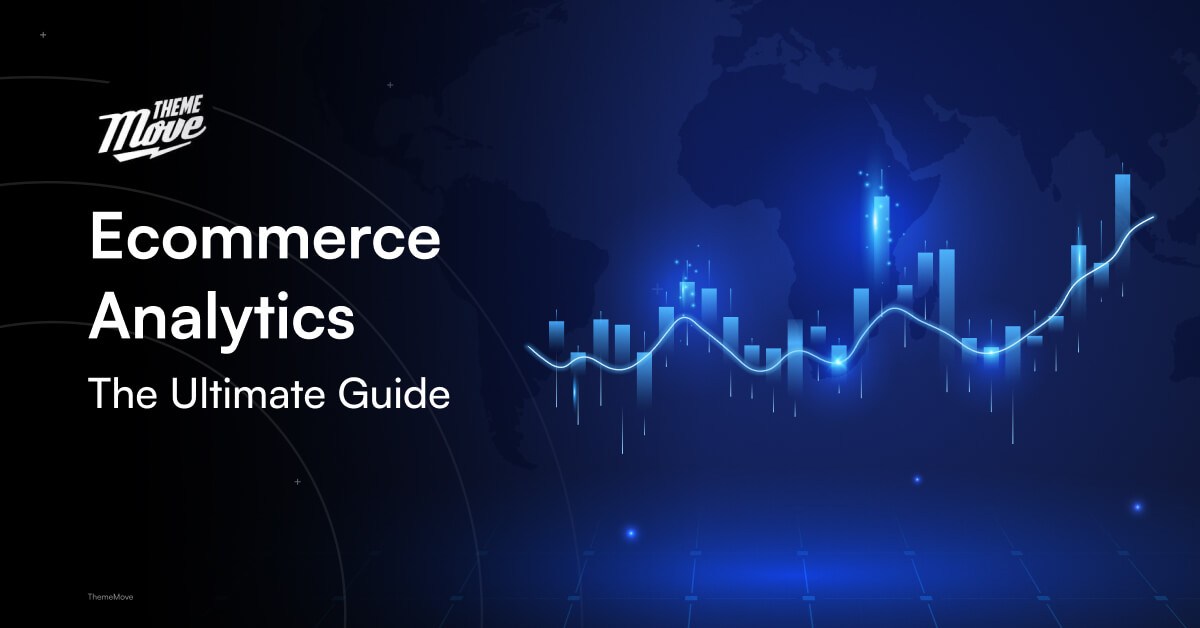In the fast-paced world of eCommerce, data reigns supreme. The ability to harness the power of eCommerce analytics has become a game-changer for businesses looking to thrive in the digital marketplace.
In this ultimate guide, we’ll answer the question of what is eCommerce analytics. We’ll also explore the importance of data analytics in eCommerce, the current landscape of eCommerce analytics, and how you can leverage analytics in eCommerce to propel your business forward.
What is eCommerce Analytics?
Put simply, eCommerce analytics is the process of analyzing customer and business data generated from online transactions and interactions. Its core focus is gaining insights that can improve business performance and customer experience.
The overarching goal is understanding what drives sales and how people move through the buyer journey. eCommerce data analytics provides a factual basis for enhancing promotions, optimizing website experience, expanding offerings, and resolving issues. It gives a way to test ideas quickly and reliably.
The global eCommerce data analytics market size is expected to reach $38,029 million by 2028. Therefore, it’s rare today to find an eCommerce operation of any notable size that doesn’t practice eCommerce analytics in some form. The wealth of data that flows from digital sales and user behavior simply offers too much-untapped business value if ignored.
Most major eCommerce platforms include built-in analytics tools as a standard feature, among which Shopify Analytics feature stands out as one of the best options.
You are looking for Shopify Analytics if you need:
- A user-friendly UI and UX: minimal and clean design language
- A wide range of reports: 74 reports coming from 11 different categories
- Live view tracking: getting to know orders and visitors all over the world in real-time
Leverage your eCommerce analytics today with Shopify with $1 for the first month, and enjoy a bundle of Shopify’s growing tools from our strategic partner FoxEcom, all of which will be discounted by 15% for a lifetime.
FoxKit: All-in-one Sales Boost
Megamog: The Best Shopify theme for high-volume stores
Advantages of eCommerce Analytics
Get Customers’ Insights through Numbers
Understanding customer behavior and preferences is crucial for business success. eCommerce analytics provides the data to gain a deep, facts-based understanding of who your buyers are and what truly motivates them.
eCommerce data analytics is a powerful lens through which you can gain deep insights into customer behavior. It tracks every interaction, from the initial website visit to the final purchase decision. Data analytics in eCommerce lets you discern patterns, preferences, and pain points in the customer journey.
Uncover eCommerce Trends and Patterns
The landscape is always shifting. Recognizing emerging trends and understanding patterns in customer behavior allows businesses to adapt, innovate, and maintain a competitive edge.
Analytics in eCommerce spotlights evolving trends in user and industry tendencies over time. By scrutinizing data on product preferences, seasonal variations, and purchasing behaviors, you can identify trends before they become mainstream.
Discover top eCommerce trends in 2024 to help you stay ahead.
Evaluate the Effectiveness of Marketing & Sales Campaigns
Launching campaigns and tracking their performance is essential to attract and retain customers. However, judging what’s working and what’s not is impossible without measurements.
eCommerce analytics attributes sales and engagements back to their source. Through detailed metrics such as click-through rates, conversion rates, and return on investment (ROI), you can measure the performance of each campaign and identify which strategies resonate with your audience and which may need adjustments.
Optimize Pricing
60% of shoppers consider pricing as their first criterion affecting purchase decisions. For that reason, pricing is a delicate balance that should be prioritized. All eCommerce sellers want to reach the sweet spot where margins are strongest, but it’s often hard to achieve.
Here is where data analytics in eCommerce comes in. Analytics in eCommerce allows merchants to analyze customer responses to different price points, competitor pricing strategies, and the overall market demand. From this information, you can set your pricing to maximize profits without harming customers’ preferences.
Types of eCommerce Analytics
Analytics in eCommerce is a large field that can be categorized into 3 types: Acquisition Analytics, Marketing Analytics, and Customer Analytics.
Understanding the distinct types of analysis is pivotal for a comprehensive approach to data-driven decision-making.
| Type | Description | Important Metrics |
| Acquisition Analytics | Examining how your eCommerce sites attract customers and earn money. | Traffic sources: where website visitors are coming from, including organic search, paid advertising, social media, etc. Conversion rates: the percentage of visitors who take a desired action, such as making a purchase. Revenue: the total amount of money earned from selling products or services in your store. |
| Marketing Analytics | Evaluating the performance of your marketing efforts across various channels. | Click-through rate (CTR): the percentage of visitors who click on a specific link compared to total visitors. Return on Investment (ROI): the profitability of marketing campaigns by comparing the revenue generated to the costs incurred. |
| Customer Analytics | Understanding the behavior, preferences, and interactions of your customers. | Customer lifetime value (CLV): the total revenue a business can expect from a customer throughout their entire relationship. Purchase frequency: how often customers purchase within a specific period. Churn rate: the rate at which customers stop doing business with your company. |
How to Conduct eCommerce Analytics
Step 1: Define Objectives
Begin by clearly articulating the objectives you aim to achieve through eCommerce data analytics. Whether your focus is on understanding customer behavior, optimizing marketing strategies, or enhancing product offerings, defining specific and measurable goals is essential.
For instance, the objectives of an eCommerce store on the BFCM sales campaign could be $1 million in revenue, +15% click-through rate, -5% churn rate, etc.
Pro tip: Be focused. You can’t choose all metrics and set them as your objectives; you should prioritize some that strictly align with the business goals.
Step 2: Collect and Organize Data
Efficient data collection and organization form the backbone of analytics in eCommerce. Implement robust data collection methods, utilizing tools such as Google Analytics, Google Search Console, Ahref, etc., or the built-in eCommerce data analytics features of platforms like Shopify Analytics. Ensure that the data collected spans the entire customer journey, from website visits to post-purchase interactions.
Pro tip: Be consistent. Establish standardized data formats and naming conventions to maintain consistency across various datasets.
Step 3: Visualize Data
Visualizing data transforms complex information into clear, understandable insights. Utilize data visualization tools like charts, graphs, and dashboards to represent patterns and trends effectively. Platforms such as Looker Studio or Tableau can aid in creating compelling visualizations.
If you use Shopify, you can leverage the Live View feature in Shopify Analytics. With it, you can track multiple metrics such as orders, visitors, sessions, sales, etc., worldwide in real-time.
A notable feature of Shopify Analytics is that all your data in Live View is visualized using a model of the Earth, making it attractive and easy to observe.
Pro tip: Be selected. There are various visualization formats including charts, graphs, etc. Selecting the best visualization to represent your data and objectives is a must.
Step 4: Analyze Data
Analytics in eCommerce involves extracting meaningful insights from your visualized data. Utilize statistical methods, trend analysis, and cohort analysis to identify patterns, correlations, and areas for improvement. Compare metrics over different periods and customer segments to derive comprehensive insights.
Pro tip: Be segmented. Break down data analytics into segments based on demographics, geography, or purchasing behavior. This allows for more targeted analysis and personalized strategies.
Step 5: Draw Conclusions and Take Actions
Concluding involves synthesizing the insights gained from data analytics in eCommerce. Identify key takeaways and assess how they align with your predefined objectives. From there, formulate actionable strategies to address challenges, optimize processes, and capitalize on opportunities.
Pro tip: Be actionable. Focus on insights that directly impact your objectives. Define actions that lead to tangible improvements and align with your overarching business goals.
eCommerce Analytics Challenges
Data Quality
A common challenge that merchants face is ensuring high data quality. 54% of businesses have stated that data quality is one of their major challenges when dealing with data analytics in eCommerce.
Good analytics relies on accurate, consistent information. Over time, data collection issues can creep in and degrade insights.
Common quality issues include duplicate, inaccurate, or incomplete entries. These problems can arise from bugs, inconsistencies across devices, or human error. Low-quality data skews analysis and obscures real patterns.
How to overcome this eCommerce analytics challenge?
- Implement data validation: Establishing strict formatting protocols and input validation prevents erroneous entries. Regular audits identify faulty areas that need to be fixed
- Utilize Data Cleaning Tools: Leverage data cleaning tools and algorithms (the best is OpenRefine) to identify and rectify errors automatically.
Data Integration
As eCommerce expands across multiple sales channels, consolidating data from each source can be challenging. Insights become fragmented if each touchpoint operates independently without a unified way to track interactions.
How to overcome this eCommerce analytics challenge?
- Standardize Data Formats: Doing so will ensure compatibility and facilitate smoother integration. This includes establishing consistent naming conventions and data structures.
- Invest in Integration Tools: Middleware solutions and APIs can bridge the gap between eCommerce platforms, CRMs, and other data sources so that data can flow among different systems seamlessly.
Data Privacy and Security
92% of Americans are concerned about data privacy when browsing the Internet. Therefore, protecting customer data is a critical concern when dealing with analytics in eCommerce. With an increasing focus on data privacy regulations and an upsurge in cyber threats, ensuring the security and privacy of customer information is non-negotiable.
How to overcome this eCommerce analytics challenge?
- Comply with regulations: Stay informed about data privacy regulations such as GDPR, CCPA, or any regional compliance standards applicable to your business.
- Regular security audits: Practice regular audits to identify vulnerabilities and proactively address potential threats. This includes monitoring access controls, performing penetration testing, and staying vigilant against emerging security risks.
It’s Time to Boost Your Business with eCommerce Analytics
As we’ve covered in this guide, eCommerce analytics provides a tremendous growth opportunity for forward-thinking eCommerce merchants. Those who embrace its power to uncover meaningful insights will continually sharpen their competitive advantage in the market.




